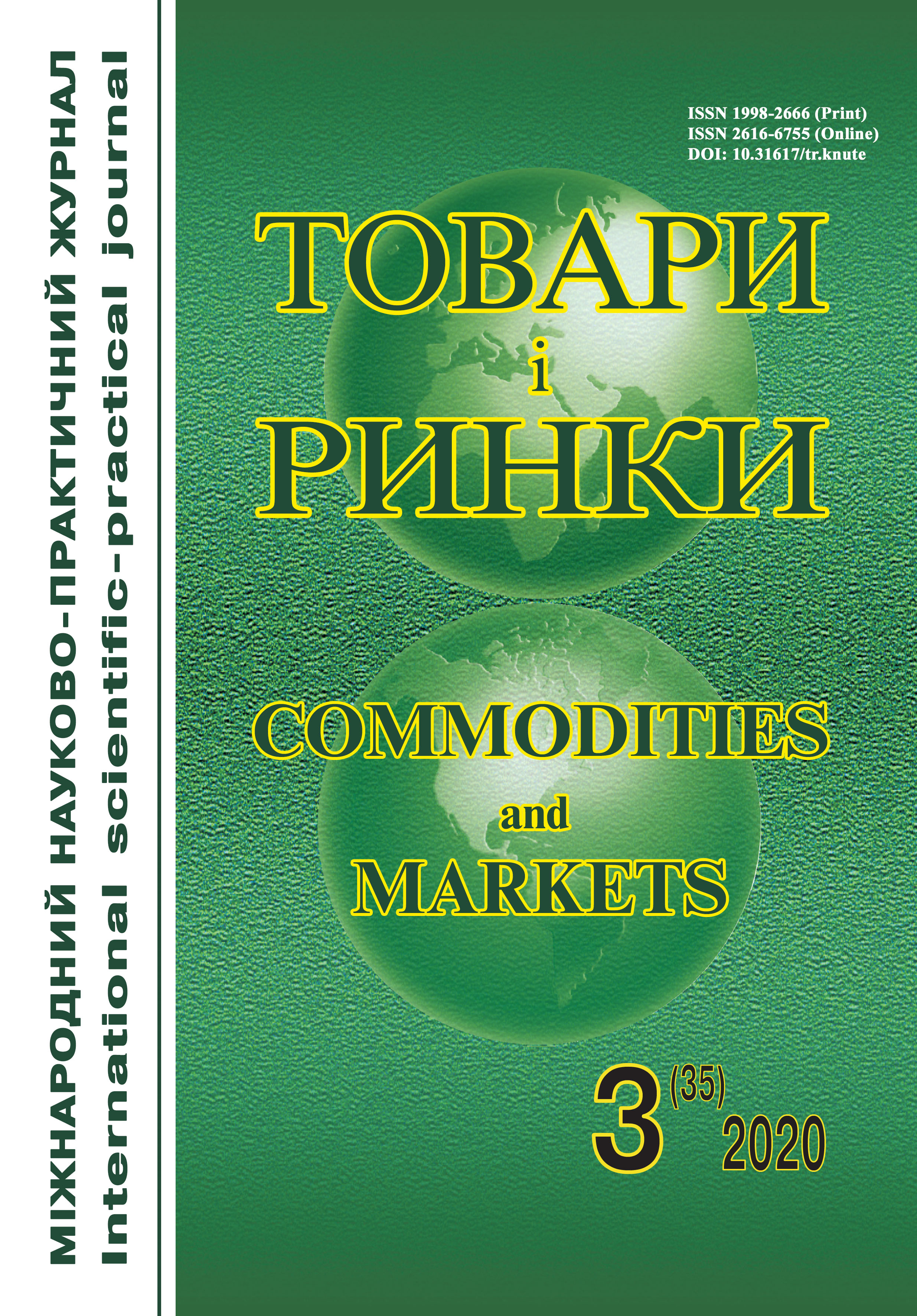Waterproof paper packaging materials: evaluation of properties
DOI:
https://doi.org/10.31617/tr.knute.2020(35)04Keywords:
paper packaging materials, hydrophobic composition, polyvinyl alcohol, polyamidamine pichlorhydrin, ureaAbstract
The results of studies of the properties of paper obtained by surface treatment of a composition based on polyamide-amine-epichlorohydrin, polyvinyl alcohol and urea are presented. A comparative assessment of the quality of industrial moisture-proof waterproof paper packaging materials and foreign-made parchment as the closest analogue was carried out.
References
Osyka, V. A., Komakha, V. O., & Koptiukh L. A. (2019). Svitovi tendentsii vyrobnytstva volohomitsnykh i vodonepronyknykh pakuvalnykh materialiv na osnovi paperu [Global trends in the production of moisture-resistant and waterproof paper-based packaging materials]. Pidpryiemnytstvo, torhivlia, marketynh: stratehii, tekhnolohii ta innovatsii – Entrepreneurship, trade, marketing: strategies, technologies and innovations: Proceedings of the II International Scientific and Practical Conference. (pp. 91-96). Kyiv: KNTEU [in Ukrainian].
Kolosov, O. Je., Sokol’s’kyj, O. L., & Malec’kyj, S. V. (2016). Doslidzhennja bar’jernyh vlastyvostej pakuval’nyh polimernyh plivkovyh materialiv [The investigation of the barrier properties of packaging polymer film materials]. Tehnologicheskij audit i rezervy proizvodstva – Technological audit and production reserves, 6 (3), 9-16 [in Ukrainian].
Flejsher, V. L., Andrjuhova, M. V., & Bogdanovich, N. I. (2017). Perspektivy ispol’zovanija bifunkcional’nyh polimerov v tehnologii bumagi i kartona [Prospects for the use of bifunctional polymers in paper and cardboard technology]. Novejshie dostizhenija v oblasti innovacionnogo razvitija celljulozno-bumazhnoj promyshlennosti: tehnologija, oborudovanie, himija – The latest achievements in the field of innovative development of the pulp and paper industry: technology, equipment, chemistry: Proceedings of the Scientific and Technical Conference. (pp. 94-97). Minsk: Belorusskij gosudarstvennyj tehnologicheskij universitet [in Russian].
Singh, P., Abas Wani, A., & Saengerlaub, S. (2011). Active packaging of food products: recent trends. Nutrition & Food Science, 4 (41), 249-260 [in English].
Iwamoto, S., Abe, K., & Yano, H. (2008). The effect of hemicelluloses on wood pulp nanofibrillation and nanofiber network characteristics. Biomacromolecules, 3 (9), 1022-1026 [in English].
Lee, H., & Mani, S. (2017). Mechanical pretreatment of cellulose pulp to produce cellulose nanofibrils using a dry grinding method. Industrial Crops and Products, 104, 179-187 [in English].
Hult, E., Larsson, P., & Iversen, T. (2001). Cellulose fibril aggregation – an inherent property of kraft pulps. Polymer, 8 (42), 3309-3314 [in English].
Kornienko, N. D., Chuprova, L. V., Pinchukova, K. V., & Mishurina, O. A. (2015). Analiz vlijanija himicheskogo sostava celljuloznyh kompozicionnyh materialov na vlagoprochnostnye harakteristiki upakovochnyh kartonov [The analysis of the influence of the chemical composition of cellulose composite materials on the moisture resistance characteristics of packaging boards]. Sovremennye naukoemkie tehnologii – Modern high technology, 9, 43-45 [in Russian].
Toland, J. (2005). New barrier coating and anti-counterfeiting technologies offer оpportunities for papermakers. Pulp вPaper international, 8 (45), 31-33[in English].
Samyn, P. (2010). Modifications of paper and paperboard surfaces with a nanostructured polymer coating. Progress in organic coatings, 4 (69), 442-454 [in English].
Silvestre, C., Duraccio, D., & Cimmino, S. (2011). Food packaging based on polymer nanomaterials. Progress in polymer science. (Vol. 36), 12, 1766-1782 [in English].
Osyka, V. A., Koptjuh, L. A., Komaha, V. O., Shul’ga, O. S., & Mostyka, K. V. (2019). Paperotvirni vlastyvosti celjulozy riznyh vydiv ta stupeniv [Paper-forming properties of cellulose of different types and grades]. Tehnichni nauky ta tehnologii’ – Engineering sciences and technologies, 1 (15), 227-234 [in Ukrainian].
Osyka, V., Koptiukh, L., & Mostyka, K. (2017). Development of wrapping paper with improved opacity, strength and whiteness. Eastern-European journal of enterprise technologies, 5/1 (89), 4-10 [in English].
Osyka, V., Karavaev, T., & Komakha V. (2020). Waterproof paper packaging materials: optimization of hydrophobic compoisition. Commodities and markets, 1 (33), 37-46 [in English].
Papir i karton. Metod vidbyrannja prob dlja vyznachennja seredn’oi’ jakosti [Paper and cardboard. Sampling method for determining average quality]. (2010). DSTU EN ISO 186:2008 (EN ISO 186:2002, IDT). Kyi’v: Derzhspozhyvstandart Ukrai’ny [in Ukrainian].
Bumaga i karton. Metod opredelenija vozduhopronicaemosti [Paper and cardboard. Method for determining breathability]. (2008). GOST 13525.14–77. Moscow: Standartinform [in Russian].
Papir i karton. Metod vyznachennja vodonepronyknosti [Paper and cardboard. Method for determining water resistance]. (1994). DSTU 2711–94 (ISO 5633:1983). Kyi’v: Derzhspozhyvstandart Ukrai’ny [in Ukrainian].
Papir ta karton. Metod vyznachennja poverhnevoi’ vbyrnosti vody pid chas odnobichnogo zmochuvannja, metod Kobba [Paper and cardboard. Method for determining the surface water absorption during unilateral wetting, Cobb method]. (1999). DSTU 3549–97. Kyi’v: Derzhspozhyvstandart Ukrai’ny [in Ukrainian].
Papir ta karton. Vyznachennja micnosti pid chas roztjaguvannja. Chastyna 1. Metod navantazhuvannja z postijnoju shvydkistju [Paper and cardboard. The determination of tensile strength. Part 1. Constant velocity loading method]. (1997). DSTU 2334–94 (GOST ISO1924/1-96). Kyi’v: Derzhspozhyvstandart Ukrai’ny [in Ukrainian].
Papir i karton. Vyznachennja micnosti pid chas roztjaguvannja pislja zanurennja u vodu [Paper and cardboard. The determination of tensile strength after immersion in water]. (2006). DSTU ISO 3781:2005 (ISO 3781:1983, IDT). Kyi’v: Derzhspozhyvstandart Ukrai’ny [in Ukrainian].



